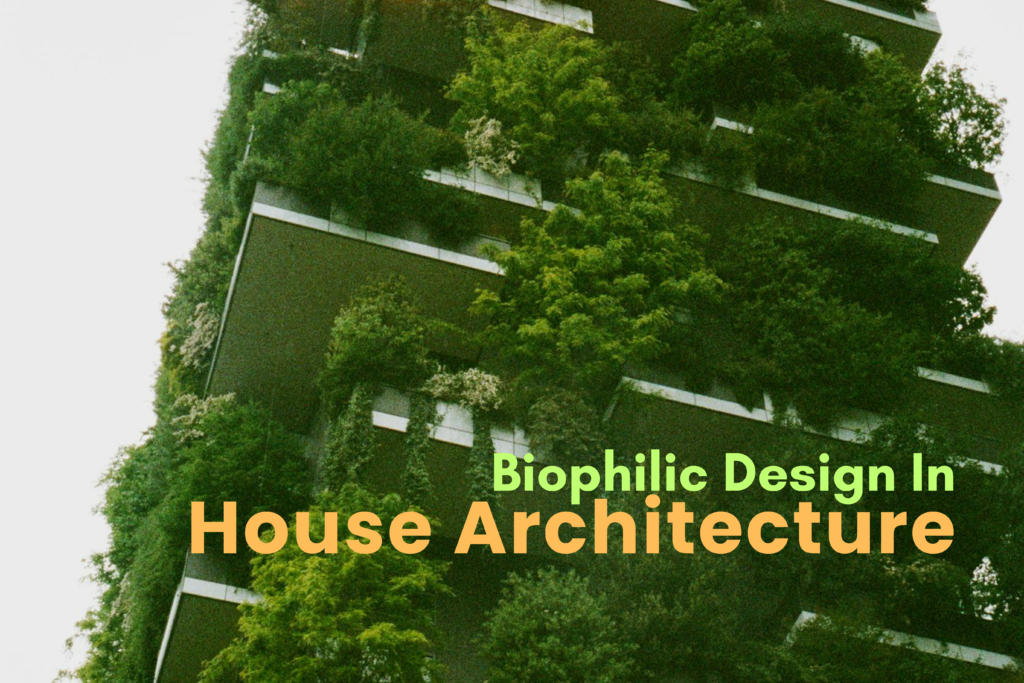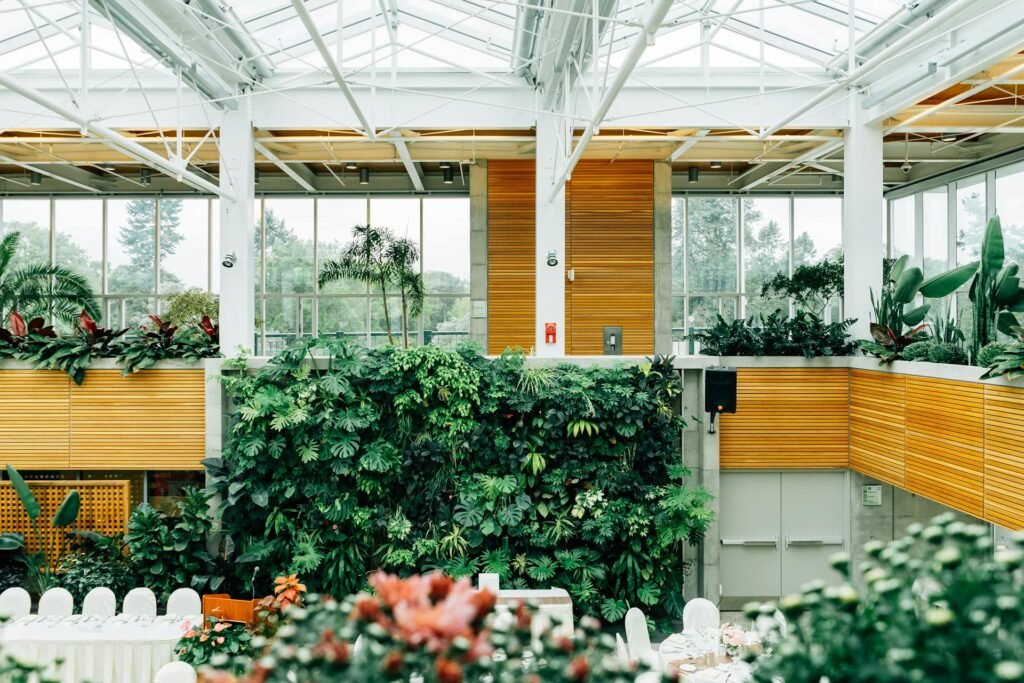In a ‘mighty world’, which seems to have lost touch with nature, the concept of biophilic design in house architecture has become a very welcoming trend.
Since the existence of humans, people used to live in raw nature, like caves and tree shads, etc., though it was very inconvenient to live in but had zero health issues. But with the ‘improvement’ of civilization, we teared apart the relationship between humans and nature. But in recent time, the trending concept of biophilic design in house architecture has made a natural restoration to human civilization.
This design sensibility is not merely skin deep; it draws on one’s basic need to belong with nature; it advocates for beauty in the environment but in the mind as well. In this article, I will examine the tenets of biophilic design, its effectiveness, and its impact on the evolution of residential architecture.
Table of Contents
What Is Biophilic Design?
The word ‘Biophilic Design’ emerged from the concept of biophilia. The concept defines the love of human beings to stay in closer proximity to nature and to other life forms. In architecture, biophilic design refers to designing built structures incorporating such aspects as natural elements in them for the purpose of improving the health and well being of the people who work or live in such spaces.
Some of the Main Aspects of Biophilic Design
Natural Light: The use of natural light is perhaps the most fundamental characteristic of biophilic design. The provisions of vast windows, skylights, and high roofs permit sunlight to invade the insides of a building, reducing the amount of artificial lighting and improving the mood.
Natural Materials: By employing elements such as wood, blocks, and soil, a design incorporates an aspect of original decorative construction. These elements serve not only a decorative purpose but also contribute to the coziness of the space by adding warmth and texture inside.
Indoors and Outdoors: Very strong links between the indoor and outdoor spaces exist or should exist. House features such as large sliding glass doors, balconies, and patios serve to extend the indoor features so that occupants can appreciate nature without stepping out of the house. This type of space is known as semi-outdoor spaces that have less enclosure around and have an extended interior part directly to the open-to-sky.
Plants and Water Bodies: The addition of the greenery, live walls, and water features brings a calming effect. Such features can purify the air and lower anxiety, which can promote good health.
Nature View: Placing windows and/or feet openings that allow views of treetops, gardens, and landscapes provides opportunities for the occupants to be in contact with nature even while relaxing in the living rooms.
Biophilic design in house architecture : The Benefits
Here are some strong benefits of biophilic design in home architecture:
Enhanced Well-Being
First and foremost, a lot of evidence has been put forth that shows how the availability of natural aspects in an environment helps in reducing stress, anxiety, and depression. The biophilic design allows the creation of an environment that is soothing to the occupants, hence helping in calming and refreshing them.
Improved Productivity
For homemakers, biophilic design offers looking for a person in two distinct aspects. Natural light and plants help to focus the mind’s eye, focusing on the work at hand and boosting the individual’s overall level of happiness.
Better Air Quality
The addition of plants as part of the furnishing and even vent systems will help boost the quality of the indoor environment in great measure. Healthier air is conducive to healthy living and may help in lessening the cases of respiratory problems.
Increased Property Value
Biophilic design no-often homes attract buyers who value their health and sustainability of resources. Such a trend is likely to translate into higher market property prices in the future.
Sustainability
Biophilic design makes people accept underutilized materials and energy conserving practices and therefore reduces impact on the environment. This is in response to the increasing preference of people to live sustainably.
The Evolution of Biophilic Design in House Architecture
Biophilic design is not a brand new concept, as some of its aspects had always been present within historic building constructions. Natural features were incorporated into structures by many ancient communities, whether it was the balmy courtyards of Roman houses or the Japanese style of structures that blended naturally with the surroundings.
Modern Uses
In recent years, however, this trend has been on the increase as urbanized society transmitted to less interaction with nature. The architects and designers are upholding biophilia principles as they understand the need to include nature in contemporary dwellings.
Example Cases
- The Eden Project – UK: This domes complex promotes the value of nature and its use – biodiversity. Its architectural hatches integrate it well with the surrounding landscape hence serving an educational yet inspiring space.
- Bosco Verticale – Italy: The Vertical Forest in Milan consists of high rise residential structures interspersed with a riot of green containing thousands of plants as well as trees. This remarkable transformation does not only beautify the environment but enriches it with cleaner air, and more living organisms within the city.
- Living Building Challenge: Ensures most of the buildings claimed to be green are actually self-sustaining buildings that are designed to improve the environment rather than the opposite. Most of the projects under this challenge resort to biophilic design in a bid to meet the goals of the challenge and promote comfort to the occupants.
Add Biophilic Design in Your Home
On the off chance that you would like to apply biophilic design in your own home, here are helpful tips that you can utilize to get started:
1. Optimize Daylight
Using bigger windows, skylights or glass ceilings would help in making the area brighten by natural light. Conscious of the position of your house, plan ways in which you will be able to capture sun rays at all angles by the time one day ends.
2. Incorporate The Use Of Natural Components
Utilize component materials that are appealing to the environment. By sustainably sourced reclaimed timber, stone, and terracotta tiles a warm look and feel can be achieved.
3. Indoor Gardening
Repurpose unused areas into indoor plants or planting corners. Place vertical gardens or hanging pots to save more space and add plants in your house.
4. Design while considering the views
When planning a new home or making any alterations to an existing one, consider how you can offer views of the surroundings. Windows and openings positioned at the correct place serve to minimize the barrier created by walls between man and nature.
5. Water Components to the Design
Incorporating something as simple as a little fountain or fishbowl can assist in the production of sound effects to an extent. It is known that water has the ability to flow and bring tranquility to those around it.
The Evolutionary Perspectives on Biophilic Design
Biophilic design will become an important aspect of residential buildings beyond the typical concern for aesthetics. Homes of the future will concentrate not only on visual aspects but also at the psychological health of the people occupying them physically.
Trends to Look For Smart Home Design
The combination of biophilic design with smart home features, helps in optimizing light and ventilation making the house even more occupiers friendly magnets.
Sustainable building practices
The growing emphasis on sustainable living will encourage more architects to include biophilic design tenets in their works, as it will no longer be treated as an option.
Socially Inclusive Designs
With the changing demographics of affluence, future residential designs may offer more design processes tha emphasize on the urban green areas which will facilitate social engagement and connection to the environment.
Conclusive Thoughts
The biophilic design in house architecture is essential as it marks a progress towards healthier and sustainable living. We can create healthier, more productive, and generally more enjoyable places by lowering or removing barriers to accessing nature where we live or work. With many architects and homeowners practicing biophilic design, it is only logical to expect a time when our houses will not be mere shells that protect us from the elements, but rather places that promote mental, physical, and emotional wellbeing. Architectural design that interacts with natural surroundings goes beyond mere design without especially incorporating it, but enjoying life more.


